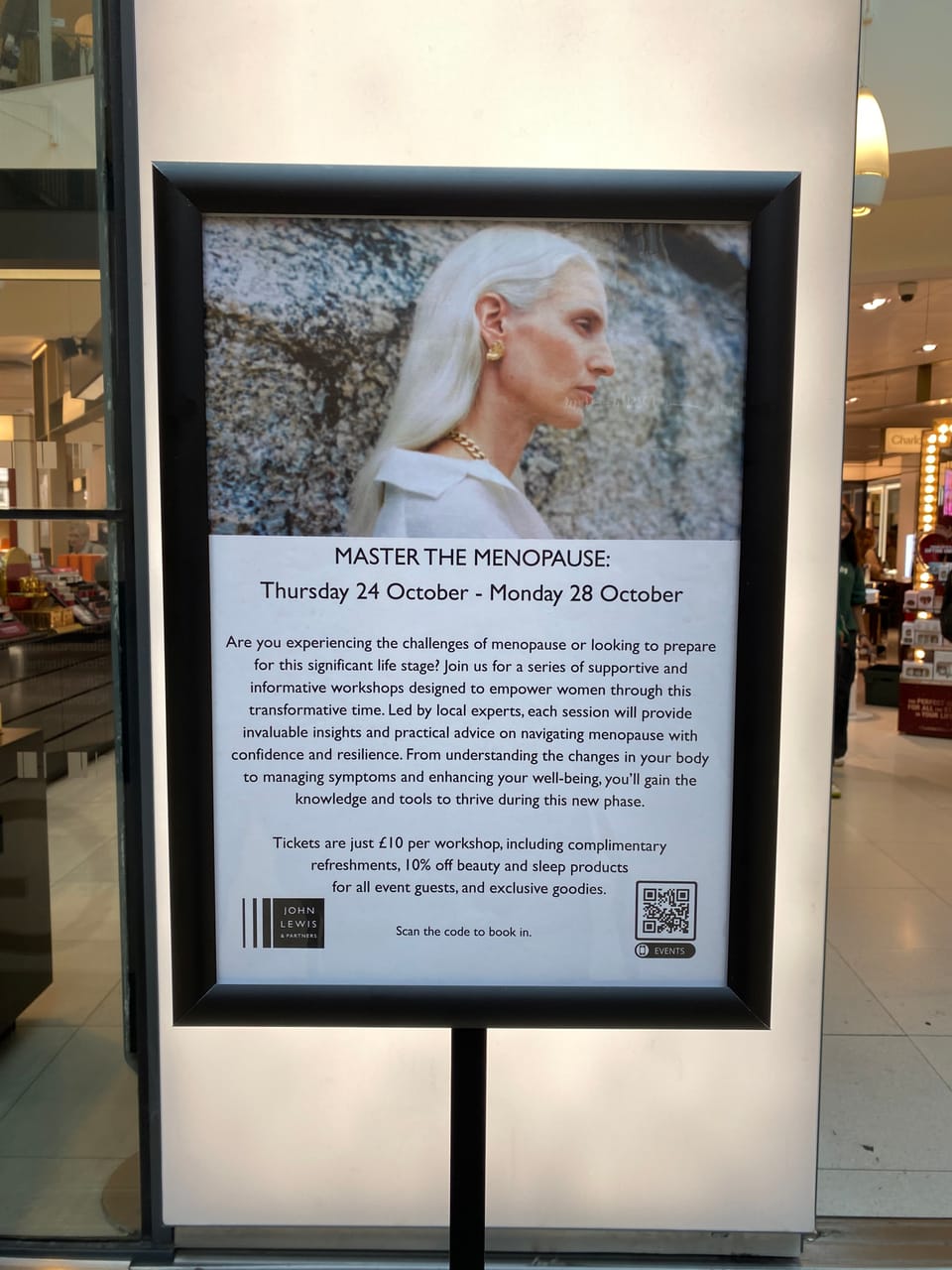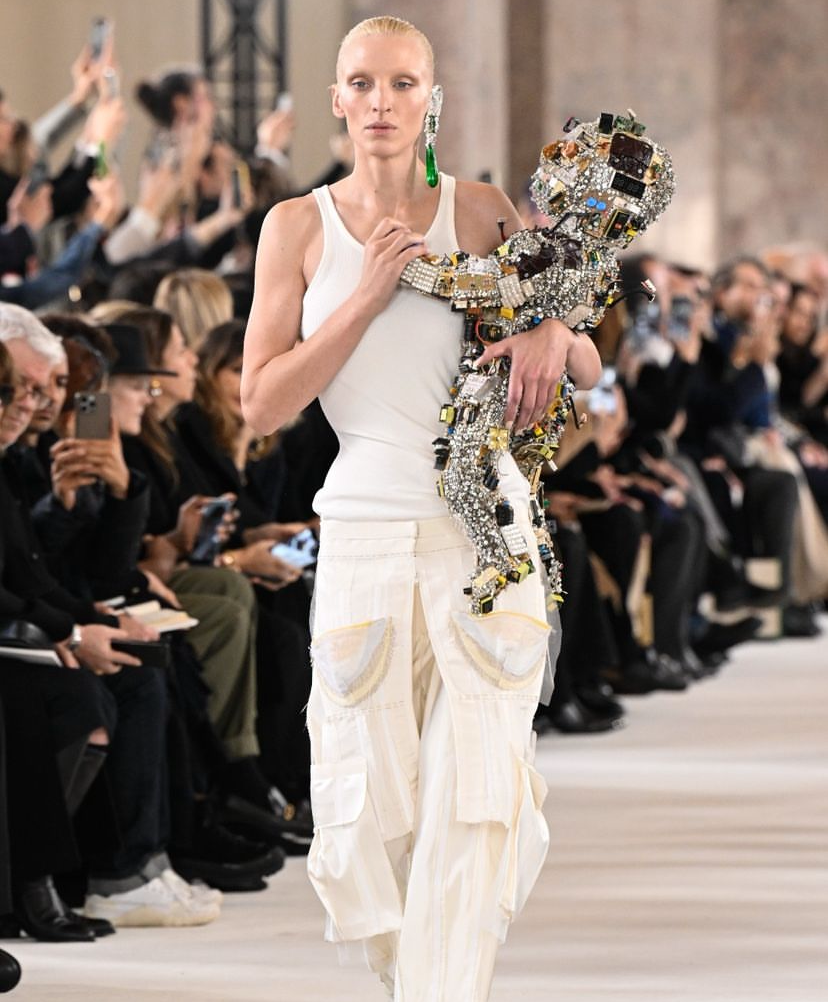Trick or -Trickle-down Transhumanism
On bodily enhancement v therapeutic interventions in two queer/feminist movies about bodily transformation, power, and aging.

In this and the next post, I talk about HRT without talking about what HRT is in medical terms. This post is about the choice between HRT as enhancement and HRT as therapy and what the limits of these choices are. I do not advocate for everyone to get on HRT. You have to need it and want it. You must make an informed choice as best you can and whatever that means within the conditions of your life.
In the span of three weeks, two Hollywood movies emerged in my attentional slipstream, the first of these literally on a plane: Love Lies Bleeding (Rose Glass, 2024), and a newer film that is in cinemas as of this writing, The Substance (Coralie Fargeat, 2024). Now this is not a film review, so I will not assess the films’ narratives, art direction, screenplays, or similar. But there are spoilers ahead. I’m interested in how these films serve as prompts for discussion about hormone replacement therapy (HRT) as a techno-scientific phenomenon that is (re)making what it means to live in a broadly global, Westernised society and culture as a gendered body, a woman, someone with a uterus. Both films force us to consider the difficult balance that must be struck if you are a woman attempting to escape misogyny through pharmaco-technologies. The balance is treacherous because escape through technologies is invariably double-edged; and we are less likely to be nimble when we are manipulable, beaten down, or hurt. As the women in these two films are. And we seek out technological solutions because, well, they’re rapid and effective when they work well. Technofixes do not work for everyone.
Thanks for reading M’s Substack! Subscribe for free to receive new posts and support my work.
My reading of the balance the films refer to relates to the therapy-enhancement continuum (Miah, 2013, pp 291-301, here), a framing I find helpful in thinking about what we put into our bodies and why we do. In the context of this post, this refers to therapeutic value of HRT to manage symptoms (of the hellishness that is perimenopause); and the enhancement end of HRT that makes you feel stronger, sexier, and empowered. The rub is that therapy and enhancement begin to blur at some point, says Miah, when something that is intended to alleviate negative symptoms can, at certain doses, begin to enhance your capabilities. Should you at this point begin to pull back and limit your use of this substance? Is there something morally, physiologically, or politically suspect about wanting to enhance yourself?
In my reading, the distinction is more nuanced; what is taken as enhancement is in fact therapy for ageism, inequality, and societal-scale misogyny.
Love Lies Bleeding is set in the late 1980s in New Mexico, where Jackie, a drifter from the Midwest, drifts in to a gym run by Lou, the daughter of a gangster under active investigation by the FBI. Jackie’s ambition is to win a women’s bodybuilding contest in Las Vegas. Lou’s ambition is to protect her sister who is trapped in a cycle of intimate partner violence, and to escape the manipulations of her gangster father. Lou, played by Kristen Stewart, is her usual smouldering self; Jackie, played by Katy O’ Brian, completely captivated me with the combination of sweet softness of on-screen character with her utterly shredded body. (You’re welcome). Lou and Jackie’s erotic intimacy is refreshing to see on screen (thank you Virgin Atlantic for not censoring it) Lou gets Jackie quickly hooked on to something - testosterone, or a performance-enhancing cocktail that contains testosterone - ostensibly to help her get an edge in her preparation for the competition. The narrative charts Jackie’s rapid ascent into physical strength; and simultaneous decline into hair trigger responses culminating in increasingly violent acts. Jackie is strong, she does not need a gun, she uses her bare fists. But the dope makes her sick, both physically and psychologically. She is driven to rage and then immediately regrets what she has done when it wears off and she comes to. She does get to Vegas, somehow escaping all the violence and she looks gorgeous and set to win the competition. But things go terribly wrong, as you know they will. This movie is heartbreaking. And it can only end with feminist magic realism in which the women ‘escape’. It has strong Thelma and Louise vibes; this is not a spoiler. Go watch it.
A review on the internet referred to The Substance as (another) long and silent scream about the beauty industry and its oppressive standards. It also trots out that beloved adage: that we are all complicit through our participation in it. We all have blood on our hands. (You’ll realise what this sentence means after you watch the unnecessary last 20 minutes). Elisabeth Sparkle (Demi Moore), is a once-loved has-been hosting a women’s 1980s-style morning aerobics show on a TV network. However, she is now deemed undesirable and unlovable because she has turned 50; the network fires her and begins recruiting for her replacement. However, she is ambitious, vain, and plucky, so she takes the opportunity to crawl back and fight for herself. A chance encounter introduces her a shadowy company that supplies her with a futuristic pharmaco-technology that allows her to create a “better” version of herself. She vacillates and is uncertain; but eventually goes for it. An apparatus of tubing, liquid food, and large needles in slick packaging, communications with unseen humans, very strict instructions, and some significant body horror later, Elisabeth ‘births’ her other, Sue. Sue is a younger, hotter, flesh-and-blood persona for Elisabeth’s consciousness, but with her own emergent conscious experience and identity. (The movie is a bit thin on some of these questions of mind/body). For seven days, Elisabeth lives in her 50 year old body. Then, for seven days, she ‘goes to sleep’ and lets Sue emerge in her athletic, toned, sexy, 20-something body. Sue relies on Elisabeth’s spinal fluid to survive. Sue gets Elisabeth’s old job and is loved by the network, the audiences, the slimy network boss. Then, the roles reverse; Sue sleeps and regenerates as Elisabeth goes about her life. That’s supposed to be the plan.
The company providing the tech warns that the protocols for how the two selves must alternate must be strictly adhered to. Or else. They clearly state that the two are in fact one. There’s a shared, but also separate consciousness that emerges between Elisabeth and Sue; for the body is not just a shell, it is intimately part of conscious awareness. And if you have two bodies, then, well, you’re going to have different kinds of conscious experiences. Yet, mind-bending-ly, Elisabeth and Sue are one, but also separate. The balance is eventually broken, because who does not want to be in the body of the loved, popular, attention-grabbing, strong, and beautiful Sue. Sue becomes addicted to this. She does not want to go back to sleep at the end of seven days. She wants to continue drawing on Elisabeth’s spinal fluid in order to survive. Elisabeth is on her way out anyway, she figures, that’s why she bought into the scheme in the first place, right. This results in the degeneration of Elisabeth physically and psychologically. I can appreciate some good body horror but there were times I really had to look away from the screen. I thought of David Cronenberg a lot during this film; I especially thought of The Fly.
Elisabeth and Jackie want a shot at stepping up their game because they know the odds are stacked against them. There is nothing actually wrong with them, they’re fine, but the world around them is intent on beating them down. Who would not want a leg up?
During both films I could not help but think about how the trans community, especially older people in transition, are navigating physical and physiological enhancement. I am not ready to formulate a question about this, I don’t yet know what intrigues me about this; but I want to get to a point of being able to understand it better. Beatriz/Paul Preciado’s Testo-Junkie is heavily underlined already.
The films made me think about how therapy and enhancement are two ends of a continuum; however the idea of a continuum as a line is limiting. I like to think of the continuum as folding into each other, like a möbius strip. According to the Stanford Encyclopedia of Philosophy , a biomedical intervention counts as therapy or enhancement depending on how it is used: “When ankle-strengthening surgery is used to improve a bicyclist’s competitive edge, it might raise enhancement concerns, but as a treatment for a bicyclist’s ankle injury, it does not.” This does not mean it is impossible to know the difference between a therapeutic or enhancement-oriented intervention; only that one has to be mindful of what function an intervention serves. One fallout of not being mindful is addiction, and not just to the pharmacotechnology itself, but to what Andy Miah refers to as ‘biocultural capital’.
This capital is how body/mind enhancement and modification “are providing tools through which people can alter themselves to more adequately pursue their life goals.” (Miah, 2013, p 296) There are two elements of this idea of capital; first, that the body is an unfinished project that is always open to re-shaping and improvement; and second, that work must be done for the capital to come to fruition, be maintained, or enjoyed. This idea of the body as something that can be improved-upon is where the transhumanist angle comes in, something that startled me to realise. Because I have tended to think of transhumanism as a convenient exit from the human condition, the preserve of the wealthy and powerful. But transhumanism has more benign dimensions to it; this is the biological, physical, and psychological enhancement of human life through prosthetics, implants, Botox injections, microneedling, HRT etc; as well as more speculative applications like ‘mind uploading’. Transhumanism has been in the news and science reporting recently because its extreme form has emerged in the fantasies of tech billionaires. Contemporary narratives of professional and personal productivity through ‘biohacking’ and preventive medicine to enhance life in old age are advanced by scientists like Andrew Huberman and Peter Attia. There is a distinctly US American cohort of gynecologists and endocrinologists who are talking about hormones and health for improved aging for women. Modest forms of bodily enhancement are trickle-down transhumanism: the slow drip of life enhancement technologies becoming more accessible to a wider range of people. In the West, people are generally in better health and living longer, or are capable of it, so transhumanist ideals and values are likely to become more mainstream through accessible interventions. New ethical and social questions will arise for many areas of inquiry, from philosophy to insurance to work and livelihoods.
The other aspect of capital of any kind is that it takes work. In the case of things we ingest, we might think of the ‘work’ as biological adaptation (Miah, p 296-97) which might include things like side effects; or, indeed, living with the personal risk of taking experimental therapies. Other interventions might require periods of pain, rest, adjustment, social isolation, or changes in everyday habits and practices. Capital also has a class dimension says Pierre Bordieu, who developed the work on capital that Miah draws on. Miah does not explore this element in much detail but mentions the familiar example of how cosmetic surgery is often a display of wealth, a kind of social enhancement, if you will. (“At least your breasts cost more than her’s” - Amy Winehouse) It could be interesting to look at how class and socioeconomic status intersect with ideas of living longer and better; who considers this a priority and how does it manifest?
Being on HRT can immediately alleviate the symptoms of perimenopause for many people, and offers some marginal superficial enhancement to the quality of skin, hair, and nails. This itself feels can feel enhancing, when it is in fact therapeutic. Someone recently said to me I barely have any lines or wrinkles and I had to admit that thanks to serums and HRT, I might have slowed the process. [Thank you also to the people who gave me my genes]. Of course I liked hearing that. This is the bit about enhancement-as-therapy-for-a-sexist-world. And then, while I was working on this post, a friend messaged me about testosterone. (I love how people refer to it as T, or testo; as if it’s our friend. Lol.) She said: “[it] makes you decisive, strong, and sexy”, and, “it makes working out with weights easier.” I am aware that there is an increased popularity of testosterone in the HRT cocktail in the UK, and social media influencers (some of who are doctors) definitely talk about it. The British Menopause Society has some guidance on it. I believe there’s an ‘enhancement-forward’ approach at work here.
There is also an awful lot that HRT is supposed to do, like protect against cardiovascular disease or cognitive health decline; however, there is not a lot of evidence that it does (I follow the advice and scholarship of Dr Jen Gunter aka Vajenda on Substack and guidelines for practitioners issued by the British Menopause Society. ) There is a risk of breast cancer associated with HRT when estrogen is taken with progesterone, although this combination is essential to prevent endometrial cancer. It feels like there is an endless series of tradeoffs to negotiate amidst a limited number of robust scientific studies. For now I am tricking my body into thinking it is still capable of reproduction, and still appreciating the therapeutic value of keeping symptoms at bay. I certainly like the light enhancment that comes with it. And I am paying attention to how enhancement enters the rhetorical tenor of online advertising and influencing about HRT. More on that in a future post.
A time will come a few years from now when I stop HRT. The challenge then will be acknowledging and accepting the limits of the body, its aging, its changing seasons. Or not.
[This post was lightly re-edited and .. errr .. enhanced on Oct 14, 2024, 5.28pm UK time]
Thanks for reading M’s Substack! Subscribe for free to receive new posts and support my work.



